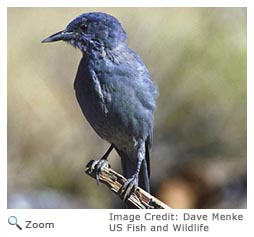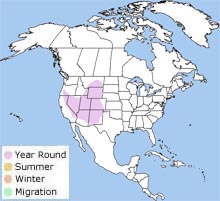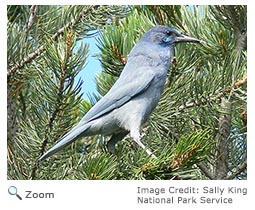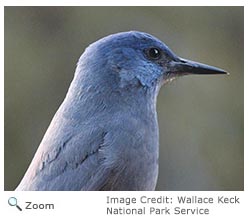Description
 The pinyon jay is about 9-11 inches in length and has a wingspan of about 18 inches. It has a long, sharply pointed black bill; a short tail; a grayish-blue to blue body; and a white chin. It has black eyes, legs, and feet. Males and females are similar, but the male has a longer bill and the crown of his head is darker. Unlike most other members of the Corvidae family, the pinyon jay doesn't have feathers at the base of its bill covering its nostrils. This lets it stick its bill deep into pine cones without getting stuff stuck on its feathers. The pinyon jay is about 9-11 inches in length and has a wingspan of about 18 inches. It has a long, sharply pointed black bill; a short tail; a grayish-blue to blue body; and a white chin. It has black eyes, legs, and feet. Males and females are similar, but the male has a longer bill and the crown of his head is darker. Unlike most other members of the Corvidae family, the pinyon jay doesn't have feathers at the base of its bill covering its nostrils. This lets it stick its bill deep into pine cones without getting stuff stuck on its feathers.
Range  The pinyon jay is found from central Oregon and Montana south to central Arizona, New Mexico, and northwestern Oklahoma. Pinyon jays do not migrate. The pinyon jay is found from central Oregon and Montana south to central Arizona, New Mexico, and northwestern Oklahoma. Pinyon jays do not migrate.
HabitatThe pinyon jay is found on dry mountain slopes and foothills near pinyon-juniper forests. It may also be found in sagebrush, scrub oak, chaparral communities, and pine forests.
|
|
Diet  Most of the pinyon jay's diet is made up of pinyon pine seeds. It opens pine cones with its sharp bill and removes the seeds. It stores the seeds in the fall to eat in the winter and early spring. The pinyon jay has a very good memory and can find the seeds it has hidden, even under cover of snow! It also eats some insects, nuts, and fruits. Most of the pinyon jay's diet is made up of pinyon pine seeds. It opens pine cones with its sharp bill and removes the seeds. It stores the seeds in the fall to eat in the winter and early spring. The pinyon jay has a very good memory and can find the seeds it has hidden, even under cover of snow! It also eats some insects, nuts, and fruits.
Life Cycle
 The female pinyon jay lays 2-5 eggs in a cup-shaped nest made of grass, bark, and pine needles placed on a platform of twigs 3-6 feet up in a pine, oak, or juniper tree. The eggs hatch in about 16 days and the chicks fledge in about three weeks. Both parents care for the young. The pinyon jay nests in colonies. The female pinyon jay lays 2-5 eggs in a cup-shaped nest made of grass, bark, and pine needles placed on a platform of twigs 3-6 feet up in a pine, oak, or juniper tree. The eggs hatch in about 16 days and the chicks fledge in about three weeks. Both parents care for the young. The pinyon jay nests in colonies.
Behavior
Pinyon jays live in large flocks that can have as many as 500 birds. A pinyon jay may spend its entire life in the flock it was born into. The pinyon jay population varies depending on the availability of pinyon pine seeds. In years when there aren't many seeds, the pinyon jay population drops.
|


 The pinyon jay is found from central Oregon and Montana south to central Arizona, New Mexico, and northwestern Oklahoma. Pinyon jays do not
The pinyon jay is found from central Oregon and Montana south to central Arizona, New Mexico, and northwestern Oklahoma. Pinyon jays do not 
